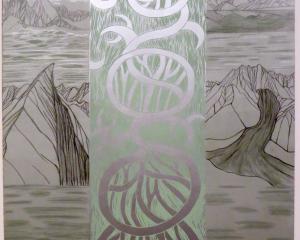Middlebrook is distinctly an up-and-coming talent. Her packed canvases abound with creative ideas, yet never to the point of feeling overly fussy.
They strike the viewer like the unfiltered thoughts of a fantail mind, flitting and hopping around to see the various angles and ideas of a scene. The paintings are prelapsarian Edens of children and wild animals amidst a world still unfinished, and the work bears repeated viewing with ease, new features and forms continually coming to the eye.
Robinson's gently stylised still lifes are charming, quiet pieces, their simple structures impressing with their careful composition. The standout work of those presented is the one large piece, its neo-cubist framework showing both a clear, clean working style and also the artist's courage and skill at assessing when a painting is complete.
Philip Maxwell also delves into structure and colour with his fine series of works based on studies of children's building blocks. Again, it is the largest work which impresses the most, a delicately composed graphite drawing.
The young ceramicist has been making waves in the New Zealand art scene with her fine porcelain works, and in this, her first full solo exhibition, she presents two series, one a direct continuation of earlier work, the second an extension upon it.
The former of these series consists of translucent porcelain feathers painted with thin black slip then carved back to create patterns reminiscent of cultures from North America to the South Pacific. These are set against a black backdrop and backlit, the individual pieces taking on a life of their own with their deep, delicate glow.
These works surround a second series, where the idea of the feather as a tribal totem is extended. This series consists of porcelain quivers filled with feather-fletched arrows, the heads of which have been individually created from porcelain, gouged and marked to imitate flaked flint points. The quivers feature images of predator and prey, the objects becoming sacred fetish symbols of a hunter's religion. The items become the enigmatic narrators of some faux-archaeological ceremony, a neo-Lascaux work in which the full import of symbol and design remain a shrouded yet evocative mystery.
The works' great strength is, paradoxically, also a slight failing. The pieces are beautifully realistic, precise images of the photographed landscape. In this, however, they run the risk of removing the essential artist's input by rendering them pure photography rendered in paint. We are inspired by the scenes depicted more than by the skill which has transferred them to canvas, which is a shame, as there is clearly talent here. Luckily for the viewer and the artist, a few small bird studies do capturing a hidden yet essential quality in a subject a mere photograph would not.
All this is not to detract from the beauty of the works. In several, notably a sweeping panorama of Glentanner Station and the two Antarctic vistas, Connolly has masterfully captured the grandeur of the setting, beautifully recreating these awe-inspiring scenes on canvas.







![Untitled (c. mid 1990s, [pink 3]), by Martin Thompson, 415mm×590mm. Photo: courtesy of Brett...](https://www.odt.co.nz/sites/default/files/styles/odt_landscape_small_related_stories/public/story/2024/02/untitled_pink_3.jpg?itok=Q0aQrc9o)




